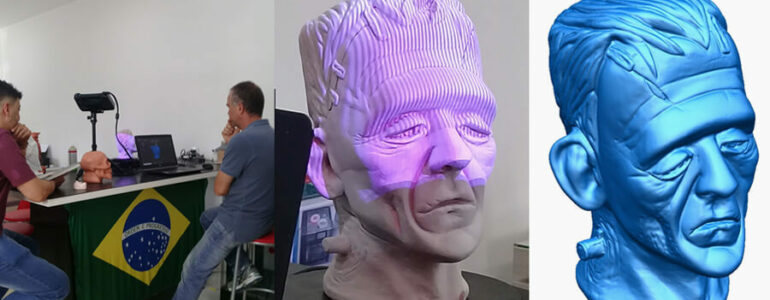21/02/22

As artists explore more artistic expressions, they find that 3D printing technology can enhance their vision, transforming their imaginary ideas into tangible entities. As a result, more artists regard 3D printing as a medium of artistic expression, opening up more opportunities to blend art and technology.
“Frank” is a series of polymorphic works of art created by Luiz Gustavo Paffaro, who used 3D printing in the early stages of his process to transform clay sculptures. Working with Raise3D’s Pro2 Plus printer, he turned his ideas into reality, and magnified them several times, giving clay sculptures new textures and shapes.
“Nothing does more to calm the mind than a firm purpose – a point on which the soul can fix its intellectual gaze.” Quote from the book Frankenstein by Mary Shelley
Inspired by Mary Shelley’s classic “Frankenstein”, Brazilian artist Luiz Gustavo Paffaro created a series of Frankenstein-themed artworks including paintings, clay sculptures, and prints.
“Frank” final prototype and others products from Paffaro Studio
The “Frank” is a series of sculptures created using 3D printing, providing opportunities for exploring new challenges for Paffaro. In choosing 3D printing as a medium for creating the “Frank”, Paffaro used state-of-the-art technology to make an artistic transformation of the creature created by Dr. Frankenstein’s unorthodox scientific experiments in Shelley’s novel, “Frankenstein“.
Sculpture creation and finished products by the artist
The initial clay sculpture shaping process involved talent, patient observation, and creation. The sculpture is about 15 centimeters high, and it took Paffaro about 15 days to sculpt it. Paffaro revisited past Frankenstein-themed paintings he created and added more details to his Frank sculpture with the intent to further inspire viewers.
The challenge in this project was to insert reverse-engineering techniques into a truly handcrafted artistic process to create unique, large-scale works. 3D printing is a valuable tool for an artist to deconstruct a sculpture and then reshape it.
To extract Frank’s shape data, Luiz Gustavo Paffaro, with the assistance of Raise3D’s Brazilian distributor UP3D, used a 3D scanner to digitize the shape of the entire sculpture and obtain complete data, then refine the details of the model using a computer.
Reverse engineering process at UP3D
The next step was to further deconstruct the sculpture. Using Raise3D’s slicing software, ideaMaker, UP3D engineers converted the digital version of the sculpture into a slicing file that the 3D printer can recognize. ideaMaker has built-in parameter templates for different printing materials, so even users who have no experience with 3D printing can still adjust the parameters of the model. For this artwork, Paffaro used PLA, an environmentally friendly and biodegradable filament, because this was in line with the artist’s concept of environmental friendliness. ideaMaker provides super high-precision templates for PLA, giving models a high level of accuracy.
The Texture function built into ideaMaker allowed Paffaro to apply various textures to the model’s surface. Paffaro added a marble texture to the model, resulting in a different texture in relation to the original clay sculpture. Paffaro stated “It’s amazing how 3D printing imitates marble. I was impressed when I saw the final model. With this piece, UP3D convinced me that the entire process works perfectly!”
For artists, 3D printing has become a unique tool to expand their creative power. This time, Paffaro made use of Raise3D’s Pro2 Plus professional 3D printer to recreate the Frank work with new materials. The Pro2 Plus’s 305 x 305 x 605 mm (12 x 12 x 23.8 inches) print volume can accommodate oversized sculptures. After more than 200 hours of printing, the model sheds the icy clay look and achieves a breezy texture and fine marble finish. As a professional-grade 3D printer, the Pro2 Plus printer has unparalleled high print resolution and positioning accuracy. The smallest nozzle diameter of this dual extruder 3D printer is 0.2mm, and the smallest print layer height is only 0.01mm, which perfectly produces the Frank’s folds and hairlines. With features and capabilities as those found the Pro2 Plus, artists can incorporate 3D printing into their process to produce high quality work.
3D printing can be used as a new artistic medium, enabling artwork to acquire a post-industrial aesthetic. For artists, the biggest advantage of 3D printing is to create an “idea-object” dialogue channel. 3D printing saves artists the process of repeated modeling, allowing them to get their own materialized ideas in just a few hours. This is not possible with any subtractive manufacturing technology. Raise3D’s range of 3D printers provides higher precision, a larger printing size, and support services, allowing artists without a technical background to easily use 3D printing technology. 3D printer technology can be used as another method for art creation, allowing artists to work through limitations and obstacles with quality results.
Luiz Gustavo PAFFARO is Brazilian, was born in Vinhedo, in the interior of São Paulo, and since 1997 has been professionally dedicated to the Arts. As an advertising person, he worked for large agencies such as Y&R, Tigre, Motorola, etc. With sensitivity, in a personal and original way, his creations are authentic, carrying his friendly and good-humored personality. In everything he does – sketches, canvases, caricatures – he achieves an objective connection with everyday life, transmitting his essence with colors and lines in a unique way, this is his personal trademark.
This case is provided by Raise3D Brazil ResellerUP3D company.